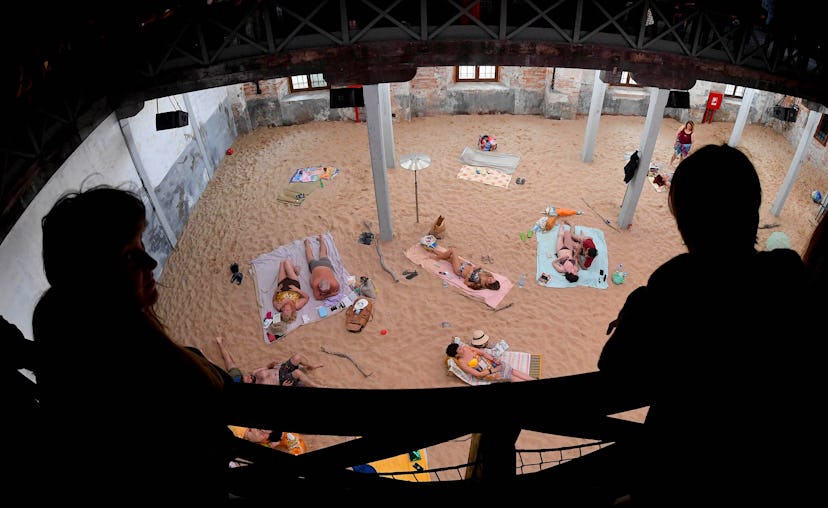Venice Biennale 2019: All the Art That’s Making Italy Even More Instagrammable

Even before it officially opened on Saturday, the 2019 Venice Biennale had already put Frieze Week to shame. The number of participants may pale in comparison to those who took over New York City earlier this month, but the 79 artists featured in “May You Live in Interesting Times,” the main exhibition of the biennale’s 58th edition, are particularly significant; for the first time, half of those who contributed works to the Corderie dell’Arsenale, a former shipyard, and the Central Pavilion of the Giardiani are women.
According to the curator Ralph Rugoff, rather than sticking to a specific theme, each of the works reflects “the precarious aspects of existence today.” Still, themes have already begun to emerge—particularly in the realm of international crises such as migration, surveillance, and one that’s particularly poignant for the city of Venice: global warming.
But all that’s just the beginning of the biennale’s sprawl over the city. Ninety nations have also set up individual pavilions to showcase their own curated exhibitions—including, for the first time, Ghana, Malaysia, Pakistan, and Madagascar. (For the time being, the entrance to Venezuela’s pavilion is still padlocked, amid the political turmoil between the country’s disputed president, Nicolás Maduro, and Juan Guaidó.) Still, even among such company, several artworks are generating enough buzz to set themselves apart—and not just in Italy. Here, a guide to those that have managed to take over Instagram feeds across the world.
Shoplifter, aka Hrafnhildur Arnardóttir, has transformed Iceland’s pavilion into this year’s selfie destination of the biennale. Her installation, titled Chromo Sapiens, is essentially a makeshift grotto shrouded by strands upon strands of synthetic multicolor hair, echoing with a soundtrack by the Icelandic heavy metal band HAM.
In a perplexing and rather disturbing turn of events, the Swiss-Icelandic artist Christoph Büchel has created another selfie destination, in the form of a massive fishing boat. In stark contrast to Venice’s ostentatious fleet of superyachts, the vessel that Büchel has displayed is more or less a mass grave: the real-life vestiges of the deadliest Mediterranean shipwreck in decades, which claimed the lives of more than 800 migrants when the fishing vessel crashed into a cargo ship en route from Libya to Italy, in April of 2015. Unsurprisingly, its resurrection has already made for quite a bit of controversy.
This year’s Golden Lion winner for national participation can be found near the Arsenale in another former naval site taken over by three Lithuanian artists: Rugilė Barzdžiukaitė, Vaiva Grainytė, and Lina Lapelytė. With the help of 35 tons of Lithuanian sand, they’ve transformed the venue into a fake beach for Sun & Sea (Marina), a performance piece made up of “beachgoers” singing an opera about climate change.
Another showstopper is The Death of James Lee Byars, a gilded tomb created by the titular artist in 1994, while he was dying of cancer, installed at the center of the Église Santa Maria della Visitazione.
On a lighter note, the artists Cyprien Gaillard and Tavares Stratchan have both illuminated the biennale with light-based installations. Whereas Stratchan’s contribution of a neon skeleton hangs from the ceiling of the Arsenale, Gaillard’s is only fleetingly present; his take on Max Ernst’s Fireside Angel, painted in 1937 as a critique of fascism, is essentially a hologram.
The Philadelphia-based artist Alex Da Corte also turned to neon for a portion of his installation, which references figures from Mister Rogers to Bart Simpson to Prince.
Meanwhile, outdoors, Lorenzo Quinn brought his signature monumental hands back to Venice. The last biennale found them rising from the depths of one of the city’s many canals to grasp onto a building as a call to action for addressing climate change. This year, his installation Building Bridges evolved into something slightly more hopeful; Quinn hopes that the six 50-foot-tall structures spread the message of “overcoming differences and build[ing] a better world.”
Related: The Most Absurd Culprits Behind Damaged Artworks, From Cornflakes to Champagne Corks